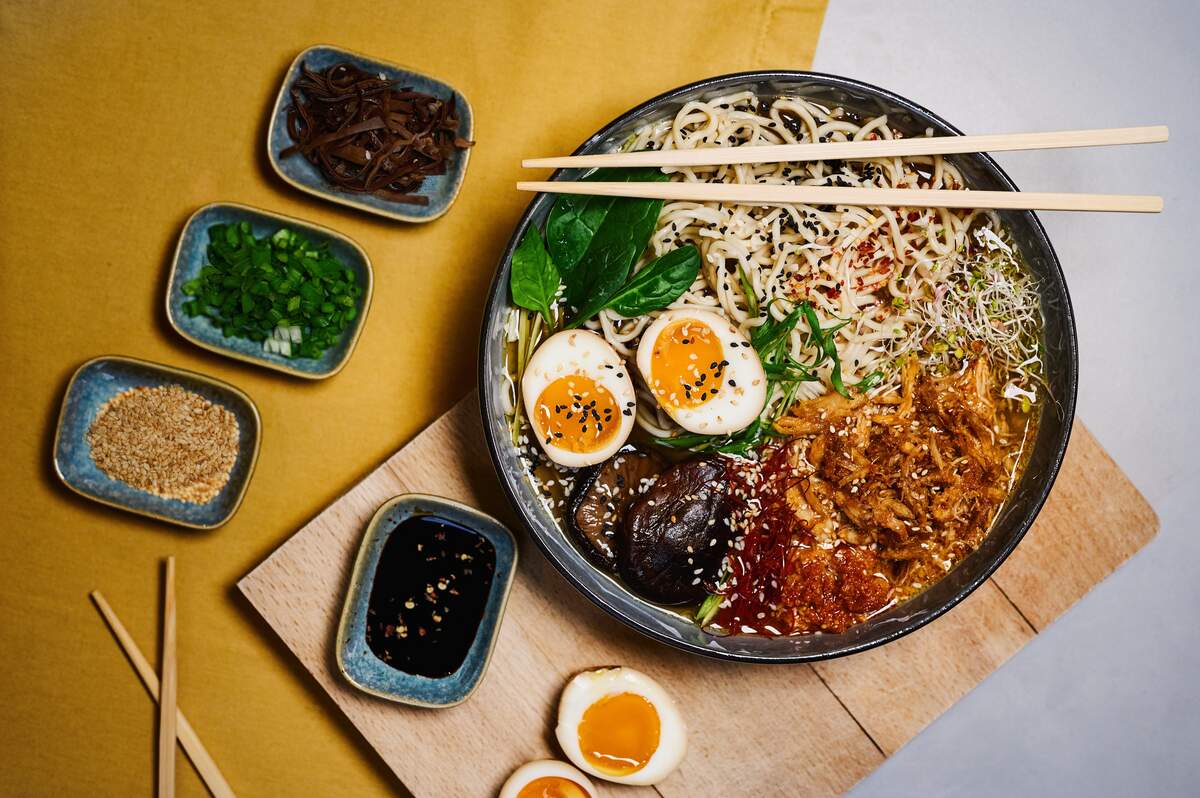

Ramen Noodle Day
Also known as
National Ramen Noodle Day
Observed
annually on April 4th (since 2017)
Dates
Tags
Food & Drink
Hashtags
Sources
https://blog.thenibble.com/2016/10/31/tip-of-the-day-quick-homemade-ramen-soup/
https://san-j.com/blog/what-is-ramen/
https://www.britannica.com/topic/ramen
https://www.japan-guide.com/e/e2042.html
https://www.usatoday.com/story/travel/experience/food-and-wine/2018/04/04/ramen-noodle-day/482602002/
https://www.voicemagazine.org/2022/04/01/tribute-to-ramen-noodle-day/
Ramen, a Japanese dish made with noodles, broth, and toppings, is celebrated and enjoyed today on Ramen Noodle Day. Ramen is not only a food, but an important part of Japanese culture. It's not definitively known when ramen was first made, but there's a belief that Chinese traders brought it to Japan in the 1880s, to the port city of Yokohama, where a Chinatown was established and Chinese restaurants were opened. This dish was called lamian, which means "hand-pulled noodles," and it is believed that "ramen" is the Japanese pronunciation of the word. This early ramen, which consisted of noodles in broth topped with roast pork, was also called "chuka soba," and became popular in port cities like Nagasaki and Yokohama. It was sold from food carts called yatai as well as in Chinese restaurants. This was during the Meiji era (1868 through 1912), a time when Japan became a modern nation and began engaging in the world scene. The first real ramen restaurant, Rairaiken, opened in 1910 in Asakusa, Tokyo.
Ramen's popularity grew in Japan with the influx of cuisines from European countries and America that were meat-based, which increased the production of meat in the country. It became even more popular after World War II but remained a meal that was eaten at a restaurant for a special occasion. Restaurant ramen is still considered to be a fine cuisine today. There are a few main factors that facilitated ramen becoming a staple food in Japan in the Postwar Years. First, rice production was decreasing—there was a particularly paltry rice harvest in 1945—and wheat production was ascendant. Wheat was used not only to make bread but also noodles, which were used to make ramen. Second, government restrictions on outdoor food vendors were loosened in 1950, leading to ramen vendors setting up shops all over the country. Today, ramen is widely available and inexpensive in Japan. It is not only found in ramen restaurants, called ramen-ya, but in other restaurants, and even at convenience stores and vending machines.
Ramen is eaten with chopsticks and is also often accompanied by a Chinese-style spoon, which is used to drink the soup and pick up small toppings. Ramen is made with Chinese-style wheat noodles that range from chewy to soft but usually are cooked al dente so they are chewy. The noodles are made of wheat flour, salt, water, and kansui, an alkaline water solution that gives the noodles a unique flavor and springy texture. Ramen noodles typically are long and elastic, but there is a lot of variation. Most ramen broths are made with a combination of the Japanese soup stock dashi and chicken or pork stock, and a different tare, or flavoring base, is added before serving. The main ramens are made from shoyu, miso, shio, and tonkotsu broths.
Shoyu ramen, the original and most common type of ramen, has a light, clear-brown broth. Translated to "soy sauce" in Japanese, shoyu has a meaty, soy sauce-forward flavor, although it's not meant to be overpowered by it. The broth is usually boiled for hours with meats—sometimes pork, beef, or seafood, depending on the region—herbs, and dried mushrooms. It is usually made using chicken broth, or pork or chicken stock, and along with soy sauce, it contains mirin and rice vinegar. Shoyu ramen is often topped with marinated soft-boiled eggs, corn, bamboo shoots, and bean sprouts.
Miso ramen broth is made with fermented soybeans. The broth is thick and rich with an appearance that varies from murky brown, to white, yellow, or red. Miso ramen often includes ground pork, vegetables, and chicken stock, and has a umami flavor. The ramen originated in the Hokkaido region, where a heartier soup was needed because of the long, cold winters.
Shio, which translates to "salt," is a type of ramen with a broth heavily seasoned with salt. The broth is clear with a yellow tint and an appearance similar to chicken broth, which it is often made with. It may be flavored with other meats, with clams and fish sometimes being used. It has both a salty and umami flavor profile.
Tonkotsu ramen has a rich pork broth, a creamy and cloudy white broth that forms after pork bones are left to cook for an extended period of time and boil down. It is often flavored with pork fat and chicken broth. A favorite on the island of Kyushu, tonkotsu ramen is topped with bamboo shoots, corn, soft-boiled eggs, chashu pork, nori (dried seaweed), fried vegetables, and sliced meat.
Different prefectures and regions in Japan are known for serving their own variation of ramen, and innovation continues today across the country:
- Curry ramen, created in the Hokkaido region, became a national favorite, as did a ramen based on a Chinese dish made with shrimp and chili sauce.
- Sapporo, from Sapporo, the capital of the Hokkaido region, is miso ramen or miso-flavored tonkotsu ramen with curly noodles which may be topped with menma (fermented bamboo shoots), braised chashu pork, bean sprouts, sweet corn, and other vegetables. A pat of butter is usually added to the broth.
- Kitakata, found in the Fukushima Prefecture, has a soy sauce base and is also flavored with chicken stock, dried sardines, and pork bones. It uses a light shoyu soup and thick, wavy, and chewy noodles. Toppings include menma, fish cakes, braised pork, chashu pork, and green onions.
- Okinawa, also called soba, is found in the Okinawa Prefecture. With thick udon noodles and a seafood-flavored shio broth, it is often topped with pickled ginger, fish cakes, thick pork rib slices, and green onions.
- Asahikawa, from Asahikawa in the Hokkaido region, has an oily shoyu broth and thin and wavy noodles and is topped with chashu pork, menma, green onions, and egg.
- Tokyo ramen is very similar to general shoyu ramen, with shoyu broth flavored with dashi fish stock, and wavy noodles of a medium thickness.
- Onomichi, from Onomichi in the Hiroshima Prefecture, has shoyu broth and is flavored with dashi fish stock, usually made from seafood caught in the Seto Inland Sea. The noodles are thin, straight, and firm, and the ramen is often topped with green onions, menma, and chashu pork, with pork lard being used as flavoring.
- Hakata is prevalent in the Fukuoka Prefecture, where it's from. Its name comes from Hakata-ku, a ward in the city of Fukuoka. With thin noodles and a tonkotsu broth, it is usually topped with chashu pork.
The main side served with ramen are gyozas (potstickers), and pan-fried dumplings that are dipped in a combination of soy sauce, vinegar, and rayu (hot chili oil). Ramen noodles can also be used to make many other dishes besides ramen soup, like ramen carbonara and ramen noodle slaw.
In 1958, Momofuku Ando of Nissin Foods invented instant ramen. While it wasn't of the same quality as restaurant ramen, anyone could now make the dish by just adding boiling water, and it became a cultural sensation around the globe. Coming with noodles and a seasoning packet, beef, chicken, miso, and shrimp ramen were now quickly within reach. Ramen became a cheap go-to for college students, while others tossed the salty seasoning packet and replaced it with their own ingredients, like herbs, red pepper flakes, and curry powder. The original instant ramen was repackaged in 1971 in a styrofoam cup and called Cup Noodles, adding on-the-go convenience to an already convenient food. There are many brands of instant ramen today. No matter if ramen is made almost instantly, or labored over for hours in a kitchen, it is celebrated and enjoyed today on Ramen Noodle Day!
How to Observe Ramen Noodle Day
- Make your own ramen to enjoy and share with others. Make shoyu, miso, shio, or tonkotsu ramen or one of the many variations described above.
- Enjoy ramen at a Michelin restaurant, at a restaurant known for ramen, or at a restaurant near you.
- Enjoy instant ramen or Cup Noodles from Nissin Foods, the originator of instant ramen, or have instant ramen from another brand. Use the provided seasoning packet or get rid of it and use the noodles to make your own ramen.
- Visit the Shin-Yokohama Rāmen Museum and CupNoodles Museum in Yokohama, or the CupNoodles Museum in Osaka.
- Post how you are celebrating on social media, such as sharing pictures of ramen and places you're eating ramen at, along with the hashtag #RamenNoodleDay.





















